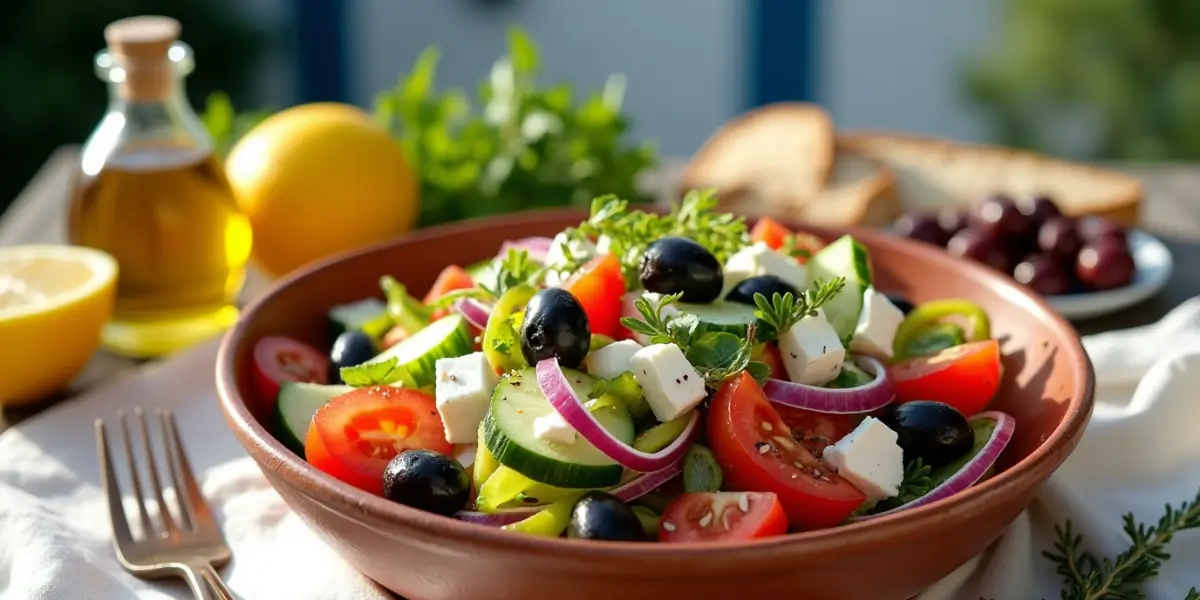The Ultimate Guide to Making a Perfect Greek Salad

Picture yourself sitting at a sun-drenched taverna by the Mediterranean, a vibrant Greek salad in front of you, bursting with fresh flavors and colors. The crisp cucumbers, juicy tomatoes, and tangy feta cheese come together in a dish that’s as simple as it is delicious. Whether you’re craving a taste of Greece at home or looking for a healthy, crowd-pleasing dish, a Greek salad is your answer. In this guide, you’ll learn everything you need to know to create the perfect Greek salad, from choosing the freshest ingredients to mastering the authentic dressing. Let’s dive into the art of crafting this classic dish that’s both a meal and a celebration of summer.
Why Greek Salad is a Timeless Favorite
A Greek salad, or horiatiki in Greek, is more than just a dish—it’s a celebration of fresh, high-quality ingredients. Its simplicity allows each component to shine, making it a staple in Mediterranean cuisine and a go-to for healthy eaters worldwide. Whether you’re a beginner in the kitchen or a seasoned cook, this guide will walk you through every step to create a Greek salad that’s authentic, delicious, and visually stunning. Plus, we’ll share tips to customize it for your taste and dietary needs.

The Essential Ingredients for an Authentic Greek Salad
The key to a great Greek salad lies in its ingredients. Fresh, high-quality produce and authentic Greek staples create the perfect balance of flavors and textures. Here’s what you need to know to get it right.
Choosing the Freshest Produce
- Tomatoes: Opt for ripe, juicy tomatoes like Roma or heirloom varieties. They should be firm but slightly soft to the touch for maximum flavor.
- Cucumbers: English or Persian cucumbers work best due to their crisp texture and minimal seeds. Peel partially for a rustic look, as is traditional in Greece.
- Red Onions: These add a sharp, tangy bite. Slice them thinly and soak in cold water for 10 minutes to mellow their intensity.
The Role of Feta Cheese
- Authenticity: Use real Greek feta made from sheep’s or goat’s milk for that creamy, tangy flavor. Avoid pre-crumbled versions, which often lack depth.
- Presentation: Serve feta in a large block or thick slices placed on top of the salad, as is customary in Greece, rather than crumbling it.
- Substitutes: If you’re dairy-free, try a vegan feta alternative made from tofu or cashews for a similar texture and taste.
Must-Have Pantry Staples
- Kalamata Olives: These briny, purple-black olives are a hallmark of Greek cuisine. Pit them for easier eating, but whole olives add authenticity.
- Olive Oil: Extra virgin olive oil is non-negotiable for the dressing. Look for Greek-origin oil for the most authentic flavor.
- Oregano: Dried Greek oregano adds an earthy, aromatic touch. Sprinkle it generously over the salad for that signature Mediterranean flair.

Ingredient Table for Greek Salad
| Ingredient | Quantity | Notes |
|---|---|---|
| Tomatoes | 2-3 medium | Ripe, preferably Roma or heirloom |
| Cucumber | 1 large | English or Persian, partially peeled |
| Red Onion | 1 small | Thinly sliced, soaked in water to reduce sharpness |
| Feta Cheese | 4-6 oz | Greek feta, served in a block or thick slices |
| Kalamata Olives | ½ cup | Pitted or whole for authenticity |
| Extra Virgin Olive Oil | ¼ cup | Greek-origin for best flavor |
| Lemon Juice | 2 tbsp | Freshly squeezed for brightness |
| Dried Oregano | 1 tsp | Greek oregano for authentic taste |
| Salt | To taste | Sea salt preferred for Mediterranean vibe |
Mastering the Greek Salad Dressing
The dressing is the soul of a Greek salad, tying all the ingredients together with its bright, tangy, and herbaceous notes. Here’s how to make it perfect.
The Classic Recipe
- Simple Ingredients: Combine extra virgin olive oil, fresh lemon juice, minced garlic, dried oregano, and a pinch of salt. Whisk until emulsified.
- Ratio: Use a 3:1 ratio of olive oil to lemon juice for balance. For a single salad, try 3 tablespoons of oil to 1 tablespoon of lemon juice.
- Make-Ahead Tip: Prepare the dressing in advance and store it in a jar. Shake well before drizzling over your salad.
Customizing the Flavor
- Vinegar Option: Some recipes swap lemon juice for red wine vinegar for a sharper tang. Use sparingly to avoid overpowering the dish.
- Herb Variations: Add fresh dill or parsley for a twist, but keep oregano as the star for authenticity.
- Spice It Up: A pinch of red pepper flakes can add a subtle kick, perfect for those who like a bit of heat.
Storing and Serving
- Storage: Store leftover dressing in an airtight container in the fridge for up to a week. Let it come to room temperature before using.
- Serving Tip: Drizzle the dressing over the salad just before serving to keep the vegetables crisp and fresh.
- Portion Control: Use about 2 tablespoons of dressing per serving to avoid overwhelming the ingredients.
Greek Salad Dressing Recipe Table
| Ingredient | Quantity | Notes |
|---|---|---|
| Extra Virgin Olive Oil | 3 tbsp | Greek-origin for authenticity |
| Lemon Juice | 1 tbsp | Freshly squeezed; substitute with red wine vinegar if preferred |
| Garlic | 1 clove, minced | Optional for a subtle kick |
| Dried Oregano | ½ tsp | Greek oregano for best flavor |
| Salt | Pinch | Adjust to taste |
Step-by-Step Guide to Assembling Your Greek Salad
Putting together a Greek salad is simple, but a few techniques can elevate it from good to unforgettable. Follow these steps for a restaurant-quality dish.

Preparation Techniques
- Chop Consistently: Cut vegetables into bite-sized chunks for easy eating. Aim for uniformity to ensure every bite has a balance of flavors.
- Layering: Place heavier ingredients like tomatoes and cucumbers at the bottom, with lighter ones like onions and olives on top.
- Feta Placement: Add the feta last, either as a block or thick slices, to make it the centerpiece of the dish.
Assembly Tips for Visual Appeal
- Color Contrast: Arrange the ingredients to highlight the vibrant colors—red tomatoes, green cucumbers, purple olives, and white feta.
- Rustic Charm: Keep the presentation slightly rustic, as is traditional in Greece, with uneven chunks and a generous drizzle of dressing.
- Garnish: Sprinkle extra oregano or fresh herbs on top for a polished look.
Serving Suggestions
- Pairings: Serve with crusty bread or pita to soak up the dressing. It also pairs well with grilled meats or fish for a complete meal.
- Portion Size: A single recipe serves 4 as a side or 2 as a main dish. Double the ingredients for a crowd.
- Timing: Assemble the salad just before serving to maintain freshness. If preparing ahead, keep the dressing separate until ready to eat.

Health Benefits and Dietary Customizations
Greek salad isn’t just delicious—it’s packed with health benefits, making it a staple of the Mediterranean diet. Here’s why it’s good for you and how to adapt it for different diets.
Nutritional Advantages
- Heart-Healthy Fats: Olive oil and feta provide monounsaturated fats that support cardiovascular health.
- Rich in Antioxidants: Tomatoes, cucumbers, and red onions are loaded with vitamins and antioxidants that boost immunity.
- Low-Calorie Option: A typical serving is under 200 calories, making it ideal for weight-conscious eaters.
Customizing for Dietary Needs
- Vegan: Swap feta for a plant-based alternative and ensure your olives are free of non-vegan additives.
- Gluten-Free: Greek salad is naturally gluten-free, but double-check any store-bought dressing for hidden gluten.
- Low-Carb/Keto: Increase the feta and olives while reducing onions to keep carbs low without sacrificing flavor.
Tips for Maximizing Nutrition
- Fresh is Best: Use organic, locally sourced produce when possible to maximize nutrient density.
- Portion Control: Stick to recommended serving sizes to balance calorie intake, especially if adding extras like pita or grilled protein.
- Seasonal Variations: Incorporate seasonal vegetables like bell peppers or radishes for variety and added nutrients.
Nutritional Breakdown per Serving (Approximate)
| Nutrient | Amount | Notes |
|---|---|---|
| Calories | 180 kcal | Based on a single serving with dressing |
| Fat | 14g | Mostly from olive oil and feta |
| Carbohydrates | 8g | Primarily from vegetables |
| Protein | 5g | From feta cheese |
| Fiber | 2g | Contributes to digestive health |
Conclusion: Bring Greece to Your Table
A Greek salad is more than just a dish—it’s a vibrant, healthy, and versatile addition to any meal. By using fresh ingredients, mastering the classic dressing, and following our step-by-step guide, you can create an authentic Greek salad that rivals any taverna’s offering. Whether you’re serving it as a side, a main dish, or a crowd-pleaser at your next gathering, this salad is sure to impress with its bold flavors and Mediterranean charm. Try making your own Greek salad today and share your creations in the comments below!
FAQ: Your Greek Salad Questions Answered
What is a traditional Greek salad made of?
A traditional Greek salad, or horiatiki, includes tomatoes, cucumbers, red onions, Kalamata olives, and feta cheese, dressed with olive oil, lemon juice, oregano,Works and salt. It’s simple, fresh, and free of lettuce, unlike many Western versions.
How do you make a Greek salad dressing?
To make an authentic Greek salad dressing, whisk together 3 parts extra virgin olive oil, 1 part lemon juice, minced garlic, dried oregano, and a pinch of salt. Adjust to taste and drizzle over your Greek salad just before serving.
Can I make a Greek salad ahead of time?
Yes, you can prep a Greek salad ahead by chopping the vegetables and storing them in an airtight container in the fridge. Keep the dressing separate and add it just before serving to keep your Greek salad fresh and crisp.
Call-to-Action: Ready to bring the flavors of Greece to your kitchen? Try this Greek salad recipe tonight and let us know how it turned out in the comments! For more Mediterranean-inspired dishes, check out our other recipes.
Are You Try This Recipe ?
There are no reviews yet. Be the first one to write one.

